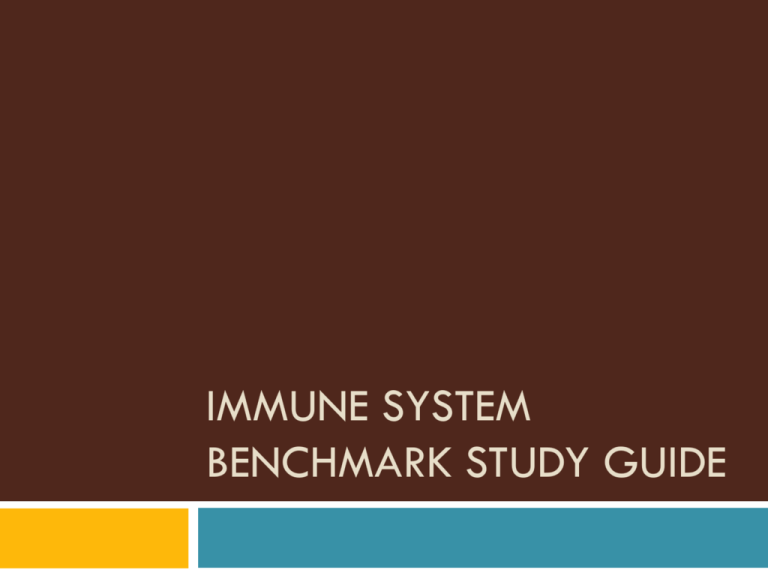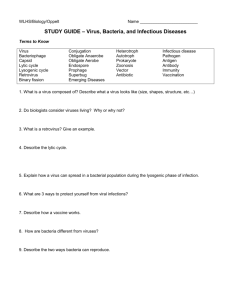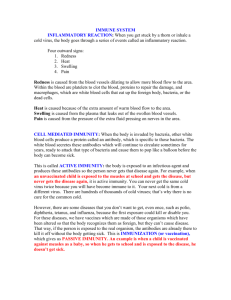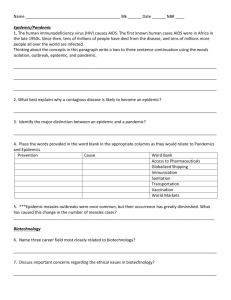Immune System Benchmark Study Guide
advertisement

IMMUNE SYSTEM BENCHMARK STUDY GUIDE What is a PATHOGEN? Anything that causes disease Can be a bacteria, virus, fungi, parasites Bacteria produce toxins Viruses lyse cells What is a VIRUS? A non-living particle that requires a host to replicate Can cause disease Found in soil, water, air, surfaces What happens during the LYTIC CYCLE? Attachment Entry DNA Replication and Virus Protein Production Assembly Lysis What happens during the LYSOGENIC CYCLE? Attachment Entry Provirus – Viral DNA is incorporated into host DNA Cell DNA with virus DNA is replicated What adaptations allow bacteria to survive in different environments? Cell Walls Can withstand harsh environments Endospores Aerobic or anaerobic respiration What are some useful uses for bacteria? Make cheese and yogurt Clean spills Make antibiotics Nitrogen fixation Recycle nutrients/decomposers Describe how Robert Koch explained the cause of disease. Steps? Pathogen is isolated from a host Pathogen is grown/cultured Pathogen is introduced to another host New host becomes ill, must have same symptoms Pathogen is isolated – must be same pathogen as original What are the causes of… Malaria – plasmodium parasite on mosquitoes Mosquito HIV – Virus Passed is a vector through exchange of body fluids Shingles – Virus Passed on by contact/droplets Define INNATE IMMUNITY First line of defense Barriers and Mucus Non-specific defense Skin Mucus membranes Tears and Saliva Lysozyme enzyme – breaks down bacterial cell walls and membranes What is INFLAMMATION? Non-specific defense 2nd Line of Defense Entry of pathogen Mast cells release histamine Histamine triggers – pain, heat, swelling, redness Dilate red blood vessels to allow phagocytes to damage site Phagocytes (macrophages, monocytes, neutrophils) digest pathogens Pus How does the body react to viral infections? Virus infected cells release INTERFERONS Interferons (chemicals) tell neighboring cells to make antiviral proteins Viruses cannot enter neighboring cells What is the function of white blood cells? Basophils – make histamine Macrophage – digest invading cells Describe 2 ways bacteria can reproduce? Binary fission Asexual reproduction One bacteria replicates DNA and divides into two cells Conjugation Sexual reproduction One bacteria passes on a plasmid or new DNA to another bacteria through pili What is ACQUIRED IMMUNITY? 3rd Line of Defense Build up resistance Specific Immunity Body uses T and B cells against a specific pathogen Cellular Immunity Antibody Immunity Cellular Immunity 1. 2. 3. 4. 5. Pathogen is engulfed by macrophage Macrophage presents digested pathogen to Helper T Cell Helper T cell activates Cytotoxic T cells Cytotoxic T cells signal infected cells to commit “suicide” Memory Cytotoxic T cells are made Antibody Immunity Pathogen (bacteria) is engulfed by macrophage Macrophage presents digested bacteria to Helper T cell Helper T cell activates B cell B cell turns into plasma cell Plasma cell makes Antibodies Antibodies circulate through blood stream to find and collect bacteria What is PASSIVE IMMUNITY? Receive Antibodies by injection or breast feeding Passive – you DON’T make antibodies yourself Temporary What is ACTIVE IMMUNITY Occurs Naturally – You build up immune system You have to get sick Body makes memory B and T cells What is an ANTIBIOTIC? Most come from penicillin Target – bacterial infections CANNOT be used on viruses Break down the cell walls What is RESISTANCE? When a bacteria is no longer sensitive to antibiotics








